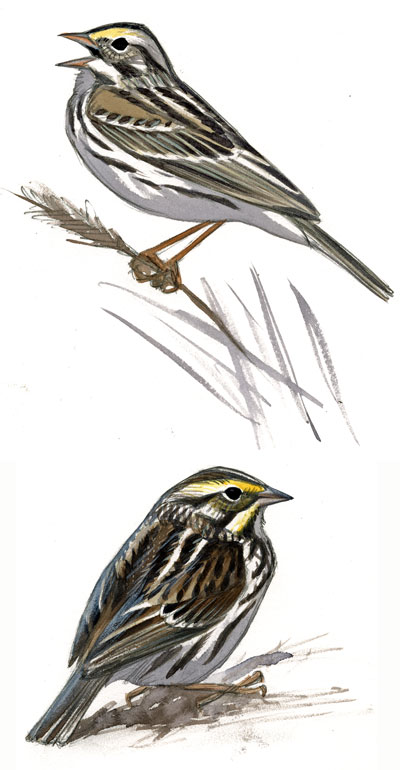
Identifying subspecies adds richness to your birding by adding another layer of understanding. What’s more, during spring migration, behavior can offer a quick and fairly reliable clue to use when distinguishing local breeders from migrants.
This is simply an extension of a bit of advice often given for identifying shorebirds: to watch for birds around the margins of the flock or in different habitat. No matter what species you are observing, paying attention to behavior can help draw attention to an interesting individual and help sort out the birds that might be worth more study.
I was enjoying the excellent birding in the Detroit Lakes area of Minnesota in spring 2007 when I noticed that two different populations of Savannah Sparrows were represented there.
Some were singing from tall perches in the expansive grassy fields — staying within a small area, chasing rivals, and generally acting territorial as one would expect from a local breeder.
Others were acting differently — traveling in small groups, often flying long distances, avoiding the large patches of habitat, and instead feeding quietly at the margins of plowed fields and roads. These Savannah Sparrows were obviously not tied to a territory, and it seemed safe to assume that they were migrants bound for breeding areas farther north.
Once I was able to sort the birds by behavior, the differences in coloration stood out. The territorial birds were paler overall with less yellow on the face, while the birds acting like migrants were darker with more yellow. A little research confirmed that two named subspecies are expected in that area. The more southern subspecies Passerculus sandwichensis savanna is generally paler and less yellow, matching the local breeders there. The subspecies P. s. labradorius, which nests farther north, averages darker and has more yellow on the face.
Similarly, in San Diego in March 2009 I found that the quickest and easiest way to distinguish the endangered local resident Belding’s Savannah Sparrows from wintering Savannah Sparrows of northern populations was by behavior. In early March, the Belding’s were territorial, while wintering Savannah Sparrows in the same area were in roving flocks, acting like wintering birds. Differences in plumage and proportions were also apparent on close study, but I almost always knew which were Belding’s without raising my binoculars.
A difference in behavior alone does not automatically mean that a bird is a different subspecies, but it might be the clue that leads to really interesting discoveries.

